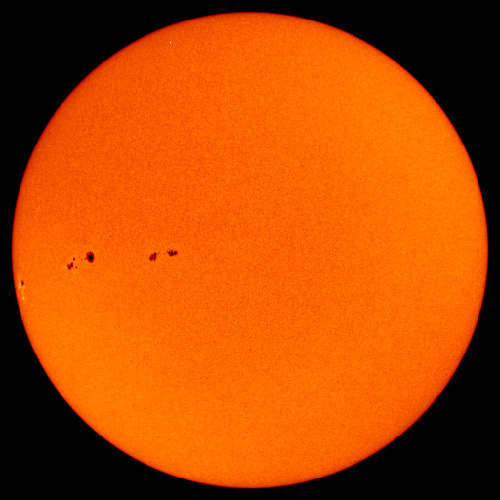Sunspots Erupt Suddenly

Aftermonths of relative quietude, a trio of new sunspot groups appeared this weekand they are all growing rapidly.
Butthere's something strange about these spots.
Sunspotsare cool regions of intense, twisted magnetic activity at the solar surface.They act like caps on the upwelling of energy, and when the caps pop, flares ofradiation and ejections of charged particles are unleashed. Major solar stormscan disrupt communications on Earth and even disable satellites.
Thesun goes through an 11-year cycle of activity. The last peak, when sunspotswere common and flares frequent, was in 2001 and 2002. The new cycle, SolarCycle 24, began recently, scientists figure, based on a sunspot with reversedpolarity appearing. But pinning down exactly when the shift occurred has provenchallenging — it might have been in 2006,sun-watching scientists reported initially, or perhaps 2007,they later said.
Addingto the tangle of understanding, the new sunspots have a magnetic polarityconsistent with Solar Cycle 23 rather than the new cycle, proving yet againthat much remains to be learned about the temperamentalsun.
Oneof the new sunspots, No. 989, kicked up a moderate solar flare Tuesday. NOAAforecasters put the odds at 50-50 for additional moderate flares today.
Solarstorms sometimes generate colorfulauroras above Earth's polar regions. No significant auroral displays areexpected this week, however.
Get the Space.com Newsletter
Breaking space news, the latest updates on rocket launches, skywatching events and more!
Thoughforecastsvary wildly, some scientists predict Solar Cycle 24 will be intense. If so,"it could have significant impacts on telecommunications, air traffic,power grids and GPS systems," according to a NASA statement issued inDecember.
- Video: Solar Storms in Action
- The Enduring Mysteries of the Sun
- Vote: The Best Images of the Sun
Join our Space Forums to keep talking space on the latest missions, night sky and more! And if you have a news tip, correction or comment, let us know at: community@space.com.

Rob has been producing internet content since the mid-1990s. He was a writer, editor and Director of Site Operations at Space.com starting in 1999. He served as Managing Editor of LiveScience since its launch in 2004. He then oversaw news operations for the Space.com's then-parent company TechMediaNetwork's growing suite of technology, science and business news sites. Prior to joining the company, Rob was an editor at The Star-Ledger in New Jersey. He has a journalism degree from Humboldt State University in California, is an author and also writes for Medium.









